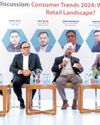STEEL SECRETARY Aruna Sharma and her team have been instrumental in the sector’s turnaround, despite the ongoing global turmoil. In a conversation with Suman K. Jha, Sharma talks about the growth of the sector, increasing per capita consumption, dealing with NPAs in the sector, evolution of private players in the steel sector and the challenges the sector is facing due to the ongoing trade wars. Excerpts:

The steel sector’s success in the midst of global turmoil is a story in itself. How do you look at this?
The journey has been really good... 2015 was a very bad year. In 2016, we realised that the sector requires immediate protection under the existing laws, and under existing laws, WTO does allow anti-dumping. So, that was worked out. We did all the homework, along with the Ministry of Commerce and Finance, we ensured that these orders were implemented, so that the steel sector could come out of the ICU. And once that was done, the whole gamut of issues were taken up — from raw material to consumption.
One big challenge was that we were a low-consumption country. We were consuming just around 60 kg per capita and to go from 50 to 59 kg we took seven years. Whereas the international average was 208 kg and China was 489 kg per capita.
We realised that steel was being replaced by alternative materials very fast over the last 40-50 years even though steel was very strong immediately after Independence. So, we worked for the amendment of the general financial rules to introduce the concept of lifecycle cost because you can execute the project in nearly one-third of the time if not half, and literally maintenance is negligible. So, with that, the consumption started going up and we are very happy to see that in the last two-and-a-half years, it has grown to the point of touching 70 kg.
Having taken care of the market part of it, we started focusing on the issues of the various sectors. The biggest problem was the NPAs. And then, the sets of problems with the PSUs. So, the problems of each set of team were flagged and the entire team started working towards those problems. We then discussed the issues related to the polices. We started with the National Steel Policy of 2017, in which we targeted that by 2030, we will reach 300 million tonnes.
Denne historien er fra July 21, 2018-utgaven av Businessworld.
Start din 7-dagers gratis prøveperiode på Magzter GOLD for å få tilgang til tusenvis av utvalgte premiumhistorier og 9000+ magasiner og aviser.
Allerede abonnent ? Logg på
Denne historien er fra July 21, 2018-utgaven av Businessworld.
Start din 7-dagers gratis prøveperiode på Magzter GOLD for å få tilgang til tusenvis av utvalgte premiumhistorier og 9000+ magasiner og aviser.
Allerede abonnent? Logg på

Technology, AI Driving Warehousing Sustainability
Anshul Singhal on how Welspun One is rapidly transforming Grade-A logistics and industrial parks across India, offering integrated fund development and asset management for large-scale warehousing solutions

DECODING RETAIL'S NEXT FRONTIER
As brands pivot towards omnichannel ecosystems and startups challenge legacy frameworks, the focus sharpens on experiential retail, sustainability and data-driven personalisation.

SORORITY OF WOMEN OF METTLE
Awinter afternoon in mid-December found quite a crowd at the Oxford Book Store on Connaught Place, as bibliophiles congregated at a corner to listen to three women authors, diverse in their passions, but drawn together by an urge to tell their story.

THE LEGACY OF THE AMARNATHS
IN NOVEMBER 2017 the management committee of the Delhi Cricket Association named the eastern stand of the Feroze Shah Kotla ground the Mohinder Amarnath stand.

PUTTING THE POWER IN THE POWERHOUSE
The Asus ExpertBook P5 is powered by an 8-core 8-thread Intel Core Ultra 7 Series 2 processor that clocks a maximum speed of 4.8 GHz, but it does not have hyperthreading. It is light weight, with a smooth glass touch pad. The laptop almost has all the I/O ports you could possibly need in a business laptop, making it an extremely lucrative option for professional computing, says

"We must be aware of our energy and water consumption"
BW Businessworld caught up with actor, philanthropist, and climate warrior BHUMI PEDNEKAR to chat about climate change and more.

"Cooking is a passport to the world"
In conversation with renowned CHEF MANJIT GILL, Advisor at Kikkoman India and President, Indian Federation of Culinary Associations (IFCA). As the former Corporate Chef of ITC hotels, Chef Gill has helped shape iconic restaurants, such as the Bukhara, Dum Pukht, and Dakshin. He has had the privilege of serving former American Presidents Barack Obama, Bill Clinton, George Bush, and the French, Canadian, British and German premiers. In 1992, Chef Gill had the opportunity of being invited to cook for Prince Charles and Lady Diana, at the Palace of the Maharaja of Jaipur. He was awarded the Lifetime Achievement Award from the Ministry of Tourism in 2007.

Strengthening Middle Management for Organisational Resilience
WHAT HOLDS AN organisation together in chaos? Is it visionary leadership, cuttingedge strategies, or robust technology?

The Retail Trailblazers
A look at companies that are making a positive impact on India's growing retail sector with their future fit business and marketing strategies.

Driving Conscious Consumerism
VIDIT JAIN, Co-founder of Kindlife, is leading the charge in revolutionising the intersection of technology and conscious consumerism.